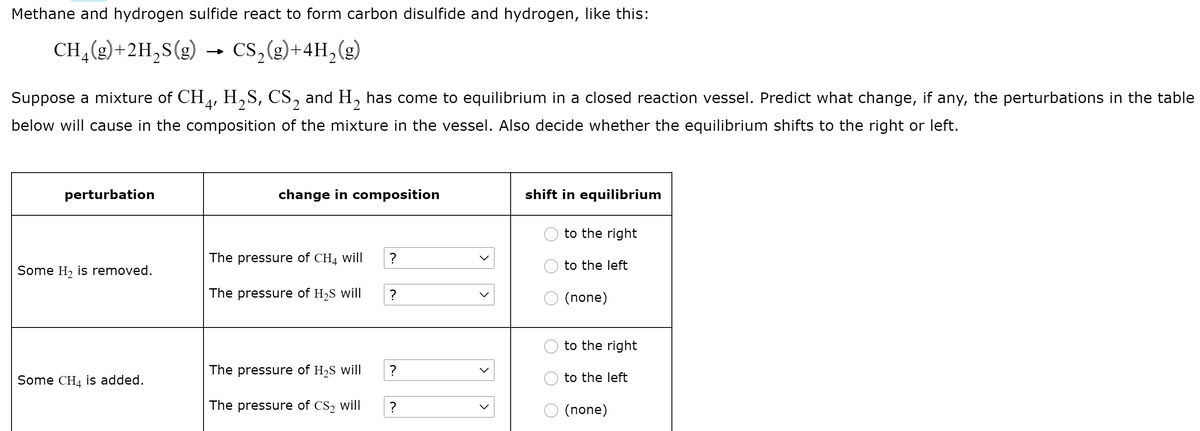Methane and hydrogen sulfide react to form carbon disulfide and hydrogen, like this: CH, (2)+2H,S(g) → cs,(g)+4H,(g) Suppose a mixture of CH, H,S, CS, and H, has come to equilibrium in a closed reaction vessel. Predict what change, if any, the perturbations in the table below will cause in the composition of the mixture in the vessel. Also decide whether the equilibrium shifts to the right or left. perturbation change in composition shift in equilibrium to the right The pressure of CH, will Some H, is removed. O to the left The pressure of H2S will ? O (none) to the right The pressure of H2S will ? Some CH4 is added. to the left The pressure of CS2 will ? O (none) O O > > |> >
Methane and hydrogen sulfide react to form carbon disulfide and hydrogen, like this: CH, (2)+2H,S(g) → cs,(g)+4H,(g) Suppose a mixture of CH, H,S, CS, and H, has come to equilibrium in a closed reaction vessel. Predict what change, if any, the perturbations in the table below will cause in the composition of the mixture in the vessel. Also decide whether the equilibrium shifts to the right or left. perturbation change in composition shift in equilibrium to the right The pressure of CH, will Some H, is removed. O to the left The pressure of H2S will ? O (none) to the right The pressure of H2S will ? Some CH4 is added. to the left The pressure of CS2 will ? O (none) O O > > |> >
Chemistry: The Molecular Science
5th Edition
ISBN:9781285199047
Author:John W. Moore, Conrad L. Stanitski
Publisher:John W. Moore, Conrad L. Stanitski
Chapter16: Thermodynamics: Directionality Of Chemical Reactions
Section: Chapter Questions
Problem 105QRT
Related questions
Question
Methane and hydrogen sulfide react to form carbon disulfide and hydrogen, like this:
CH4(g)+2H2S(g)→ CS2(g)+4H2(g)
Suppose a mixture of CH4, H2S, CS2 and H2 has come to equilibrium in a closed reaction vessel. Predict what change, if any, the perturbations in the table below will cause in the composition of the mixture in the vessel. Also decide whether the equilibrium shifts to the right or left.

Transcribed Image Text:Methane and hydrogen sulfide react to form carbon disulfide and hydrogen, like this:
CH,(g)+2H,S(g) → CS,(g)+4H,(g)
Suppose a mixture of CH, H,S, CS, and H, has come to equilibrium in a closed reaction vessel. Predict what change, if any, the perturbations in the table
4'
below will cause in the composition of the mixture in the vessel. Also decide whether the equilibrium shifts to the right or left.
perturbation
change in composition
shift in equilibrium
to the right
The pressure of CH4 will
?
to the left
Some H, is removed.
The pressure of H2S will
?
(none)
to the right
The pressure of H2S will
?
Some CH4 is added.
to the left
The pressure of CS2 will
?
(none)
Expert Solution
This question has been solved!
Explore an expertly crafted, step-by-step solution for a thorough understanding of key concepts.
This is a popular solution!
Trending now
This is a popular solution!
Step by step
Solved in 3 steps with 3 images

Knowledge Booster
Learn more about
Need a deep-dive on the concept behind this application? Look no further. Learn more about this topic, chemistry and related others by exploring similar questions and additional content below.Recommended textbooks for you

Chemistry: The Molecular Science
Chemistry
ISBN:
9781285199047
Author:
John W. Moore, Conrad L. Stanitski
Publisher:
Cengage Learning

Chemistry: Principles and Practice
Chemistry
ISBN:
9780534420123
Author:
Daniel L. Reger, Scott R. Goode, David W. Ball, Edward Mercer
Publisher:
Cengage Learning

Chemistry: Principles and Reactions
Chemistry
ISBN:
9781305079373
Author:
William L. Masterton, Cecile N. Hurley
Publisher:
Cengage Learning

Chemistry: The Molecular Science
Chemistry
ISBN:
9781285199047
Author:
John W. Moore, Conrad L. Stanitski
Publisher:
Cengage Learning

Chemistry: Principles and Practice
Chemistry
ISBN:
9780534420123
Author:
Daniel L. Reger, Scott R. Goode, David W. Ball, Edward Mercer
Publisher:
Cengage Learning

Chemistry: Principles and Reactions
Chemistry
ISBN:
9781305079373
Author:
William L. Masterton, Cecile N. Hurley
Publisher:
Cengage Learning

Chemistry
Chemistry
ISBN:
9781305957404
Author:
Steven S. Zumdahl, Susan A. Zumdahl, Donald J. DeCoste
Publisher:
Cengage Learning

Chemistry: An Atoms First Approach
Chemistry
ISBN:
9781305079243
Author:
Steven S. Zumdahl, Susan A. Zumdahl
Publisher:
Cengage Learning
